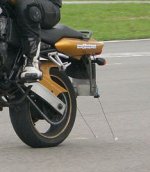gwhy! said:
zombiess said:
In order to properly do this (auto wheelie), math, physics and control theory will be required.
The other option would be to make a bang bang type controller which could be tuned by the end user. Just have a settable angle to prevent flipping and when that angle is reached, cut the throttle. The back off throttle rate could be adjusted as well, but we are talking all open loop.
If you had a pendulum arrangement like willow posted it will not be open loop , you will have a linear hall sensor so as the mag approaches the sensor the voltage goes up and as the mag moves away the voltage will go down .. in simple terms this is subtracted from the throttle voltage.
Yes that's true it is feed back (bang bang type), but hard to dial in. How would you determine the amount of throttle subtracted or added which is required to maintain a set position? What about filtering out noise and oscillations in the sensor setup? If you can ride a wheelie because you have the skills, your brain does the math and your hands/feet and body make necessary adjustments to maintain the balance and stop oscilations. If you want an electronic device with sensors to do it; it has to understand how all of this works, the desired angle to be maintained and handle any disturbances that upset the balance, dampen oscillations caused by overshoot, etc.
Lets take the hall sensor arrangement and pull the front end up really fast. The hall sensors start cutting the throttle, but how much throttle and how quickly? Will the throttle act fast enough? If not, then you flip over, too slow and the front end might come crashing back down. Both of these conditions are overshooting the desired result, a controlled balance point.
Another question is do you want to power wheelie under control or just get to the balance point and hold it there?
To better understand what is required it would be a good idea to draw a free body diagram of the forces involved in "doing a wheelie". From that, the math that describes the physics can be found and translated into transfer functions. Those transfer functions can then be placed into a control loop (probably PID) to maintain a set angle/speed, etc. Add in a speed sensor and now you can program the bike to do a controlled launch that just hovers the front wheel a 0 to x centimeters above the ground and as speed increases it could automatically bring the front down gently or it could wait and let that happen naturally.
I'm not saying this is the only way to do this, but it's most likely the best way and it is how I would do it because it opens up all kinds of options for cool features.
This is a very cool project and one I wish I was able to take on the challenge of, but I'm way too busy

Back when I thought about trying to do this earlier this year I had no idea just how difficult of a challenge it was. Someone should give it a shot, even a simple anti flip device to help people learn to wheelie themselves.




